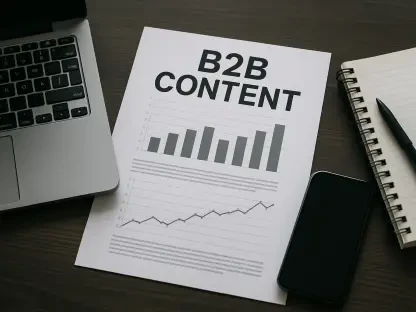What if the meticulously crafted emails and tailored content aimed at B2B prospects are missing the mark entirely, failing to connect with those truly ready to buy? In today’s hyper-competitive landscape, where every interaction counts, a staggering 73% of B2B buyers ignore messages that don’t align with their immediate needs. This gap between effort and impact is driving a revolutionary shift in marketing strategy, as AI-powered relevance emerges as a game-changer, promising to redefine how businesses engage with high-intent prospects. This isn’t just a trend—it’s a wake-up call for marketers to rethink their approach.
The significance of this shift cannot be overstated. As B2B buyers increasingly demand interactions that match their specific context and timing, traditional personalization—built on static data like job titles or company size—falls short. AI-driven relevance, by contrast, taps into real-time behavioral signals to identify prospects who are actively in the market. This transformation is reshaping the alignment between marketing and sales, cutting through the noise to deliver meaningful connections. Exploring this evolution reveals not just a new tool, but a fundamental change in how B2B success is achieved.
Unpacking the Limits of Personalization
For years, personalization has been hailed as the gold standard in B2B marketing, with campaigns designed around basic data points like industry or past purchases. Yet, this approach often assumes that a customized greeting or a targeted white paper will spark interest, ignoring whether the recipient is even considering a purchase. The result is a disconnect that leaves both buyers and sellers frustrated, as messages fail to resonate at the critical moment of decision-making.
The data paints a stark picture: 61% of B2B buyers prefer to complete purchases without any sales interaction, seeking information that directly addresses their current challenges. When bombarded with generic or mistimed outreach, many simply tune out, with a significant portion dismissing irrelevant content outright. This growing impatience underscores a critical flaw—personalization often prioritizes form over function, missing the deeper signals of buyer intent that drive conversions.
AI-Driven Relevance: A New Standard
Enter AI-powered relevance, a strategy that moves beyond surface-level customization to focus on the nuances of buyer behavior. Unlike personalization, which relies on broad assumptions, relevance uses advanced algorithms to analyze dynamic data—think website visits, content engagement, or even company-level changes like funding rounds. This approach ensures that marketing efforts target prospects who are not just a good fit, but actively ready to engage.
Take the example of platforms leveraging AI to sift through hundreds of data points in real time. These tools can detect subtle patterns, such as a spike in searches for specific solutions or increased activity on product pages, to flag high-intent leads. By prioritizing context over mere customization, AI bridges the gap between marketing metrics and sales outcomes, ensuring that every outreach is both timely and impactful.
The difference is tangible. Where personalization might send a tailored email to a thousand contacts with a 2% response rate, relevance narrows the focus to a hundred prospects showing active interest, often tripling conversion rates. This precision redefines efficiency, allowing teams to allocate resources where they matter most, fundamentally altering the B2B engagement landscape.
Real-World Impact: What the Numbers Say
Evidence of this shift is mounting across the industry. Recent surveys indicate that 43% of B2B marketers view AI-driven audience targeting as the most impactful application of technology, with expectations that adoption will soar in the coming years. Projections suggest that by 2027, a vast majority of sales leaders will integrate AI into strategic planning, highlighting the urgency of this transition.
Insights from the field further validate these trends. A marketing executive at a technology firm noted, “Our old personalized campaigns generated noise but little return. Once we adopted AI to track intent signals, our outreach became laser-focused, cutting volume but boosting results dramatically.” Such testimonials reflect a broader consensus—relevance isn’t just a buzzword; it’s a proven method delivering measurable gains.
Beyond anecdotes, the analogy to consumer tech offers clarity. Just as streaming platforms adapt recommendations based on real-time user behavior, AI in B2B marketing continuously refines its understanding of buyer readiness. This dynamic adaptability sets a new benchmark, pushing companies to rethink static databases in favor of fluid, actionable intelligence.
Bridging the Gap Between Marketing and Sales
One of the most profound effects of AI-powered relevance lies in its ability to unite marketing and sales teams around a common goal. Historically, marketing has chased metrics like email opens or downloads, often passing leads to sales that lack genuine intent. This misalignment wastes time and resources, creating friction where collaboration should thrive.
With AI, lead scoring evolves into a sophisticated process that weighs the sequence and context of actions, distinguishing casual curiosity from serious interest. For instance, a prospect downloading a case study after multiple product page visits and a pricing inquiry scores higher than one who merely clicked an ad. This nuanced qualification ensures sales teams receive leads with a higher likelihood of closing, fostering trust and synergy across departments.
The ripple effect is significant. As marketing hones in on quality over quantity, sales cycles shorten, and revenue predictability improves. This alignment transforms the handoff process into a seamless partnership, where feedback from sales outcomes continuously sharpens marketing strategies, creating a virtuous cycle of improvement.
Steps to Adopt Relevance in Your Strategy
Making the pivot to AI-powered relevance requires deliberate action, but the path is clear. Start by evaluating existing data practices, shifting from static lists to platforms that capture live intent signals, such as shifts in technology adoption or social media engagement. This foundational step ensures that targeting is grounded in current buyer behavior rather than outdated assumptions.
Next, integrate AI tools that sync with existing systems like CRM platforms, enabling automated scoring based on relevance criteria. Collaboration is also key—establish shared goals between marketing and sales, focusing on lead quality rather than sheer numbers. Finally, commit to iterative refinement, using sales results to fine-tune AI models, ensuring predictions grow sharper over time. These actions form a practical framework for embedding relevance into B2B operations.
Beyond implementation, cultural adaptation plays a vital role. Teams must embrace a mindset of precision, letting go of volume-driven tactics in favor of strategic focus. This shift, while challenging, positions organizations to meet modern buyer expectations, delivering interactions that resonate deeply and drive lasting impact.
Looking back, the journey from personalization to relevance marked a pivotal moment for B2B marketing. Reflecting on this transition, it became evident that success hinged on understanding and acting upon true buyer intent. For companies eager to stay ahead, the next steps involved investing in AI capabilities, fostering cross-team collaboration, and continuously adapting to evolving data insights. These efforts promised not only immediate improvements in engagement but also a sustained edge in a market where relevance reigned supreme.









